|

Presence
of Program GHG Mexico at the National Strategy of
Climate Change (ENAC)The
last May 25th, the Mexican president Felipe Calderon
presented the National Strategy of Climate Change
(ENACC), where the Program GHG Mexico is included as an
effective initiative of the industrial sector to fight
climate change , through the accounting and report of
Green House Gas Inventories, and identification of
improvement opportunities and emission reductions...
Relaunching of Program GHG
Mexico
Within
the framework from the Agreement signed between the
Secretariat of the Environment and Natural Resources
(SEMARNAT), the Consejo Coordinador Empresarial through
the Commission of Studies of the Private Sector for
Sustainable Development...
Public recognition to the
companies who have Publisher their
report of GHG emissions inventory The Secretary of
the Environment and Natural Resources recognized fifteen
Mexican companies who launched the Voluntary Program... COP11
The eleventh
session of the Conference of the Parts of the Convention
of Climatic Change (COP 11), was carried out in Montreal
with the first meeting of the parts of the Protocol of
Kyoto... COP12
In November of
2006, at the city of Nairobi it was organized the
twelfth conference of the Parts of the Convention of
Climatic Change (COP 12) where it was reviewed...
Presence of Program
GHG
Mexico
at the National Strategy of Climate Change (ENACC)
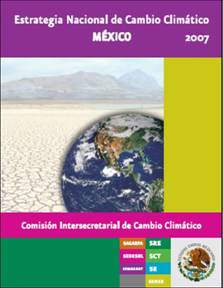 The
last May 25th, the Mexican president Felipe Calderon
presented the National Strategy of Climate Change
(ENACC), where the Program GHG Mexico is included as an
effective initiative of the industrial sector to fight
climate change , through the accounting and report of
Green House Gas Inventories, and identification of
improvement opportunities and emission reductions The
last May 25th, the Mexican president Felipe Calderon
presented the National Strategy of Climate Change
(ENACC), where the Program GHG Mexico is included as an
effective initiative of the industrial sector to fight
climate change , through the accounting and report of
Green House Gas Inventories, and identification of
improvement opportunities and emission reductions
The
presentation of the ENACC at Los Pinos, (official
residence of the president), counted with the presence
of some distinguished national and international
personalities like Doctor Mario Molina; Alicia Barcenas
Ibarra, Assistant Secretary of the United Nations;
Michael Zammit, Secretary of the Convention of Climatic
Change and Ambassador of International Environmental
Subjects of Malta, among others.
The
Strategy identifies areas of opportunity, measures and
ranks of reduction of emissions, besides to propose the
necessary studies to define more precise goals of
mitigation. Also, it outlines the necessities of the
country to advance in the construction of adaptation
capacities; in other words it defines the general
direction of the actions and analyzes the net mitigation
potential by area.
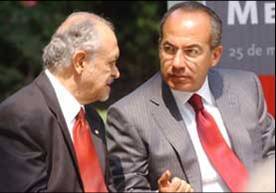 Besides
the roll of the industrial sector, the president
recognized the public and private companies which have
begun to make the accounting and the report of their GHG
inventories, and invited to more companies to be part of
this initiative that already has allowed to report near
90 million tons of carbon dioxide. Also, he emphasized
that in this front,
Mexico
is pioneering between the developing countries, since it
is the only one that has displayed three national
communications with complete inventories calculated
based on international methodologies. Besides
the roll of the industrial sector, the president
recognized the public and private companies which have
begun to make the accounting and the report of their GHG
inventories, and invited to more companies to be part of
this initiative that already has allowed to report near
90 million tons of carbon dioxide. Also, he emphasized
that in this front,
Mexico
is pioneering between the developing countries, since it
is the only one that has displayed three national
communications with complete inventories calculated
based on international methodologies.
On
the other hand, Calderon talked about the efforts in
impelling the sustainability through the social and
economic sectors. This holistic approach at the public
policies is a necessary condition for its success. The
importance of this multiple parties relationship is
demonstrated through the participation of seven
dependencies of the Federal Government to the
development of the ENACC. The
seven dependencies - Secretariat of Agriculture,
Communications and Transport, Economy, Social
Development, Energy and Foreign Relations, in addition
to the SEMARNAT- integrate the Commission
Intersecretariat of Climate Change.
In
his speech, Doctor Mario Molina remembered the cost of
inaction and the leader role that
Mexico
could play between the developing in the promotion of
the international agreements required to face the
problem. Also he said that “it would be irresponsible
to inherit to the future generations a degraded
environment which makes difficult to achieve lifestyle
like or better than ours”
From
the perspective of United Nations, Alicia Barcenas,
remembered that the climate stability is an
environmental global asset thus, the global heating is
an international issue. Therefore from her point of view
it is necessary to take global actions. She about the
three special envoys, Mrs. Brundtland; ex- president
Ricardo
Lakes
; and Seung Soo, whom have a very special function and
it is that they are going to engage a dialogue with all
the presidents of the world so from upper of the
political level they will know what the obstacles that
each country is facing are
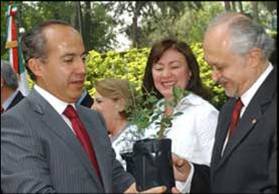 Finally,
Michael Zammit Cutajar focused his speech in three
aspects, the first one that the launching of the
strategy is a sample that at
Mexico
the subject of climatic change has ascended to the upper
level of the governmental policy. Second,
the strategy indicates the will of Mexico to commit
itself progressively to adopt policies and measures that
help the development of the economy in a sustainable
way; and third, the strategy confirms once again, that
the country is arranged to share with confidence and
transparency information on its objectives, its national
policies, their efforts and to discuss this information
without complexes with its colleagues in the
international community Finally,
Michael Zammit Cutajar focused his speech in three
aspects, the first one that the launching of the
strategy is a sample that at
Mexico
the subject of climatic change has ascended to the upper
level of the governmental policy. Second,
the strategy indicates the will of Mexico to commit
itself progressively to adopt policies and measures that
help the development of the economy in a sustainable
way; and third, the strategy confirms once again, that
the country is arranged to share with confidence and
transparency information on its objectives, its national
policies, their efforts and to discuss this information
without complexes with its colleagues in the
international community
The
National Strategy of Climate Change affirms the
commitment of
Mexico
, and recognizes the Global Heating as a national
problem. The
president invites all the Mexicans, agriculturists,
legislators, mass media, entrepreneurs, etc. to revalue
the importance of the environment and to understand that
without an environmental balance there will be no sector
that survives. He cited “is about the future, is about
the ones who will comes, is about our dear country, to
finish soon, is about our world”
Relaunching of Program GHG
Mexico
 Within
the framework from the Agreement signed between the
Secretariat of the Environment and Natural Resources
(SEMARNAT), the Consejo Coordinador Empresarial through
the Commission of Studies of the Private Sector for
Sustainable Development (CCE/CESPEDES), World Business
Council for Sustainable Development WBCSD) and the World
Resource Institute (WRI), the Program GHG Mexico arose
some years ago. The event called by the SEMARNAT, the
Private and Public Sectors, try once again to support
and strengthen the commitment of the government as of
the industrial sector to develop early actions to fight
the climatic change. Within
the framework from the Agreement signed between the
Secretariat of the Environment and Natural Resources
(SEMARNAT), the Consejo Coordinador Empresarial through
the Commission of Studies of the Private Sector for
Sustainable Development (CCE/CESPEDES), World Business
Council for Sustainable Development WBCSD) and the World
Resource Institute (WRI), the Program GHG Mexico arose
some years ago. The event called by the SEMARNAT, the
Private and Public Sectors, try once again to support
and strengthen the commitment of the government as of
the industrial sector to develop early actions to fight
the climatic change.
Program
GHG Mexico, has the objective to reinforce the promotion
of the participation from the private sector to develop
projects that contribute to the reduction of green house
gases
The
climatic change is a topic that has received an enormous
meaning, the year 2006 was a year where the results of
scientific researches were accomplished and all of them
concluded that the climatic change is not a simple
scientific projection, it has in addition a great
economic importance and influence in different sectors
due to his nature and complexity. Therefore
a joint effort is needed to reduce the emissions
Since
its establishment in 2004, Program GHG Mexico has
offered technical qualification to Mexican companies to
develop corporative inventories Green House Gases (GHG),
through this training the participant companies are able
to identify opportunities and mitigation projects, ways
to increase their energy efficiency and to elaborate
effective corporative strategies directed to construct a
path towards sustainability and combat climatic change.
The industrial sector plays a key role for the
implementation of the actions to fight climate change,
and
Mexico
is taking the leadership to implement programs that
induce to the early and voluntary action.
Program
GHG Mexico has been received very well by the intensive
industries regarding the use of energy in
Mexico
. From
the 45 participant companies, the entire cement sector
is committed, a representative number of the iron and
steel sector, so as the brewing, mining and the chemical
sector, as well as companies of the public sector in the
case of PEMEX. The program has obtained the development
and published of 30 corporative inventories of GHG
emissions. In 2005, the emissions reported in the
corporative inventories ascended to 89 million tons of
CO2e which represents 32% of the total of the industrial
emissions from the National Inventory of GHG.
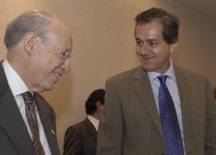 Although,
the program has been successful, Program GHG Mexico, in
this second phase intends to increase the number of
companies and to strongly motivate its participation in
international carbon markets, through emission reduction
projects. Additional to these aspects, Program GHG
Mexico tries to develop a long term vision, thus to
establish a dialogue platform in the private sector for
the Post-Kyoto agreements. Although,
the program has been successful, Program GHG Mexico, in
this second phase intends to increase the number of
companies and to strongly motivate its participation in
international carbon markets, through emission reduction
projects. Additional to these aspects, Program GHG
Mexico tries to develop a long term vision, thus to
establish a dialogue platform in the private sector for
the Post-Kyoto agreements.
The
advance and the achievements of the program depend
almost to the great extent and confidence between the
public and private institutions, the technical support
of the WRI and the WBCSD, the enterprise commitment,
alliances with chambers and associations, the
establishment of an effective committee for pursuit, and
the financing and support of international organizations
as the Global Opportunities Found(GOF) from the British
Embassy in Mexico and the Agency for the Industrial
Development from the United States (USAID).
It
is necessary to recognize that the Voluntary National
Initiative of Accounting and Report of Green House
Gases, now days known as “Program GHG Mexico”, has
achieved the consolidation of alliances between the key
actors of the Mexican society: financial organisms,
government, companies, NGOs. These last are the key
organisms which can transform the national consensuses
into concrete actions towards the combat of the climatic
change.
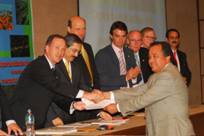 The Secretary of
the Environment and Natural Resources recognized fifteen
Mexican companies who launched the Voluntary Program of
GHG Accounting and Report and made public their report
of emission inventory. The Secretary of
the Environment and Natural Resources recognized fifteen
Mexican companies who launched the Voluntary Program of
GHG Accounting and Report and made public their report
of emission inventory.
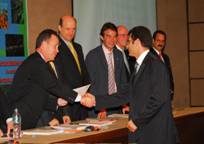 In the presence of
representatives of the private sector, the Secretary
made emphasis of the relevance of the reported GHG
emissions because they represent one fourth of the
national total emissions generated by stationary
combustion units of industrial processes. Considering
the strategic and operative relevance that has the
subject, the Secretary Dr. Fernando Tudela emphasized
the efforts of the Subsecretary of Environmental
Planning and Policies who with a set of actors has
promoted spaces for the strength of
Program GHG Mexico. In the presence of
representatives of the private sector, the Secretary
made emphasis of the relevance of the reported GHG
emissions because they represent one fourth of the
national total emissions generated by stationary
combustion units of industrial processes. Considering
the strategic and operative relevance that has the
subject, the Secretary Dr. Fernando Tudela emphasized
the efforts of the Subsecretary of Environmental
Planning and Policies who with a set of actors has
promoted spaces for the strength of
Program GHG Mexico.
Once again, the
Secretary of the Environment and Natural Resources Jose
Luís Luege Tamargo, recognized the participant
companies of "Program GHG Mexico" who made
public their report of emissions inventory .
During the event,
it was recognized the effort of the private sector in
reach synergy between the mitigation of climate change,
the operative efficiency, the power security, and the
goals of development; as well as the
importance of the investment and the innovation in the
transition towards an economy of low intensity in carbon
emissions.
The event was
carried out at Monterrey like a parallel event in the
Second Ministerial Meeting of the Dialogue of Gleanagles
on Climatic Change, Clean Energies and Sustainable
Development, where the group of the G8+5, interchanged
ideas and strategies to impulse goals and efforts in the
long term.
COP11
The eleventh
session of the Conference of the Parts of the Convention
of Climatic Change (COP 11), was carried out in Montreal
with the first meeting of the parts of the Protocol of
Kyoto. During this meeting it was carried out a parallel
event in where Program GHG Mexico offered presentations
with employees from the SEMARNAT, the WBCSD, the WRI and
some other Mexican companies’ participants. It was
presented the benefits of the Program as well as an
exploration of the future directives in the context of
the advances of the policies of climate change at
developing countries. The program was presented on
December. The 2nd.
COP
12
In November of
2006, at the city of Nairobi it was organized the
twelfth conference of the Parts of the Convention of
Climatic Change (COP 12) where it was reviewed the
implementation of the commitments, like the financial
mechanism, the national communities, the transference of
technologies, the creation of capacities and the adverse
effects of the climate change at
developing countries. Also the responses and
strategies were anaylsed in order to continue fighting
this phenomenon.
|

